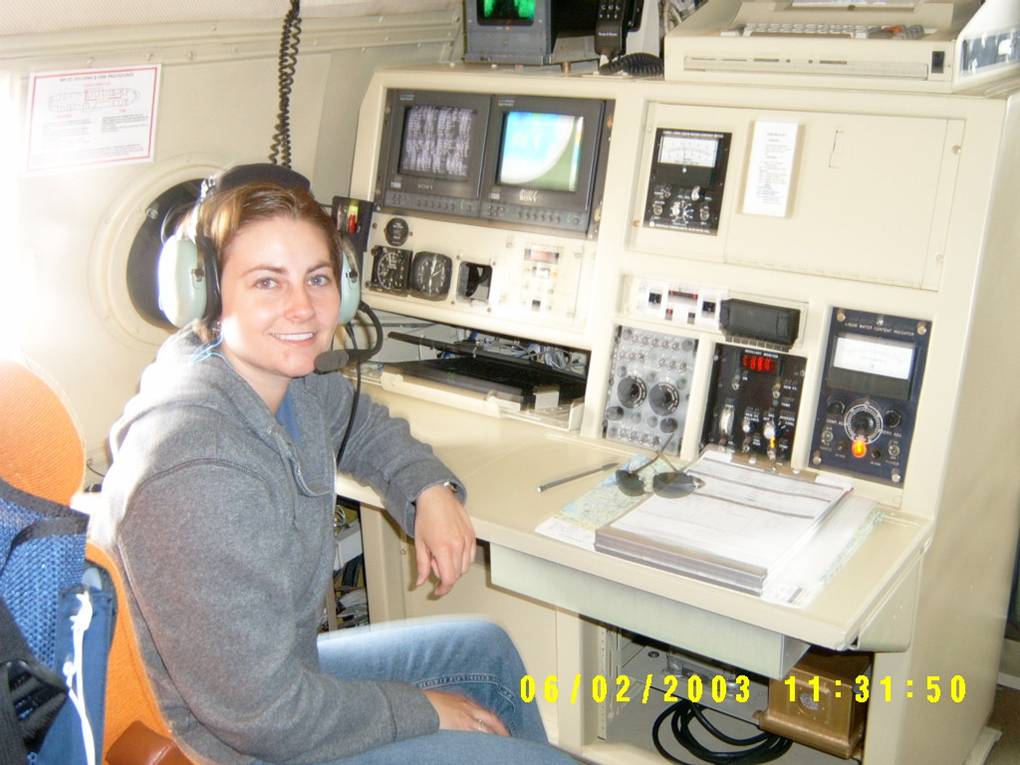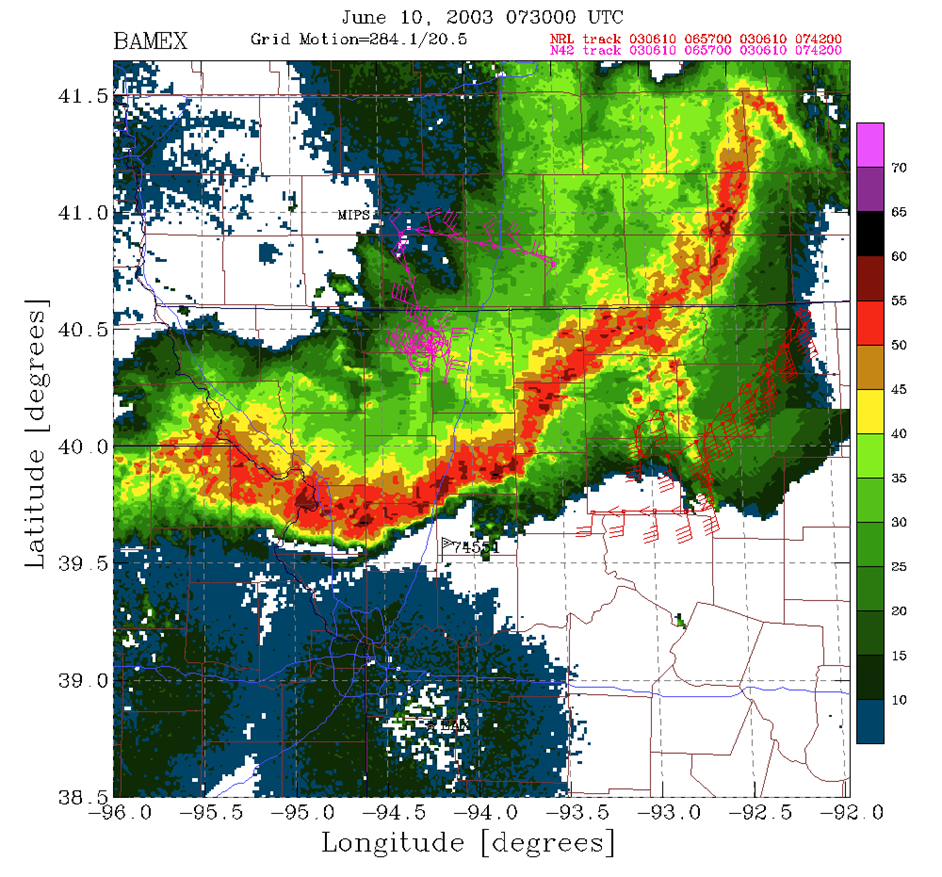
 Greg
McFarquhar
University of Illinois
Greg
McFarquhar
University of Illinois
|
BAMEX
 |
 |
|
| Graduate student Marcia Estrem at one of the data acquisition systems on the NOAA P-3 during a BAMEX flight out of mid-America airport. | Marcia Estrem poses in front of the NOAA P-3 at the mid-America airport before a flight into a MCS. | The pink line represents the flight track of the NOAA P-3, showing our spiral descent in the stratiform cloud immediately behind a bow echo so that we could study the evolution of cloud particles as they fell. The red line shows the flight track of the NRL P-3, sampling ahead of the bow echo. |
| BAMEX: The Bow Echo and Mesoscale Convective Vortex Experiment (BAMEX) was conducted out of mid-America airport in Mascoutah, Illinois between 20 May and 6 July 2003. BAMEX concentrated on studying the life cycle of mesoscale convective systems (MCSs), particularly those producing severe surface winds (bow echoes) and those producing long-lived mesoscale convective vortices (MCVs) capable of initiating subsequent convection. BAMEX investigated competing hypothesis explaining the development of severe straight-line winds, inclduing that they are caused by the production of negative buoyancy in the rear-inflow jet which is a function of the microphysical composition of the stratiform region, that they result from meso gamma scale vortices near the surface along the leading edge of the bow echo, and that they are produced by intenral gravity waves produced from perturbations of the stable boundary layer by deep convection. BAMEX also investigated the process of MCV formation which had hitherto not been well observed, and sought to understand how convection is initiatied and organized in the vicinity of long-lived MCVs. BAMEX deployed a number of facilities to answer these questions, invluding the NOAA P-3 aircraft (equipped with radar and cloud microphysics instruments), the NRL P-3 aircraft (equipped with the ELDORA radar), a Learjet (to release dropsondes to characterize the thermodynamic structure accross the MCS), and the University of Alabama Mobile Integrated Profiling System (MIPS) and the NCAR MGLASS sounding system. |
| Uof Illinois Role and Interests:The Illinois team played a central role in the conduct of the BAMEX experiment, with Profs. Rauber, McFarquhar and Jewett serving on the steering committee. In addition, Prof. McFarquhar was the lead-PI for the cloud microphysics instruments on the NOAA P-3. More than one third of the graduate students in the department participated in BAMEX, either flying on the P-3 aircraft or going on two-week long deployments of the mobile ground stations. Since the completion of BAMEX, the work of the Illinois group has concentrated on determining the extent to which cloud microphysical processes were responsible for the production of negative buoyancy in the rear-inflow jet. In particular, the horizontal and vertical variability of hydrometeors within trailing stratiform regions of MCSs based on 17 spiral descents have been characterized in the context of the radar-observed structure of the storm, and have been used to initialize and evaluate numerical models that simulated the evolution of precipitation particles in the stratiform region as they fell through the melting layer. |
Publications arising from BAMEX: Davis, C., N. Atkins, D. Bartels, L. Bosart, M. Coniglio, G. Bryan, W. Cotton, D. Dowell, B. Jewett, R. Johns, D. Jorgensen, J. Knievel, K. Knupp, W.-C. Lee, G. McFarquhar, J. Moore, R. Pryzbylinski, R. Rauber, B. Smull, J. Trapp, S. Trier, R. Wakimoto, M. Weisman, and C. Ziegler, 2004: The Bow-Echo and MCV Experiment (BAMEX): Observations and opportunities. Bull. Amer. Meteor. Soc., 85, 1075-1093. McFarquhar, G.M., M.S. Timlin, R.M. Rauber, B.F. Jewett, J.A. Grim and D.P. Jorgensen, 2007: Vertical variability of cloud hydrometeors in the stratiform region of mesoscale convective systems and bow echoes. Mon. Wea. Rev. 135, 3405-3428. Grim, J.A., R.M. Rauber, G.M. McFarquhar, B.F. Jewett, and D.P. Jorgensen, 2009: Development and forcing of the rear inflow jet in a rapidly developing and decaying squall line during BAMEX. Mon. Wea. Rev. 137, 1206-1229.
Grim, J., G.M. McFarquhar, R.M. Rauber and B.F. Jewett, 2009: Microphysical and thermodynamic structure and evolution of the trailing stratiform regions of mesoscale convective systems during BAMEX. Part II: Column model simulations Mon. Wea. Rev. 137, 1186-1205. Smith, A.M., G.M. McFarquhar, R.M. Rauber, J.A. Grim, M.S. Timlin, B.F. Jewett, and D.P. Jorgensen, 2009: Microphysical and thermodynamic structure and evolution of the trailing stratiform regions of mesoscale convective systems during BAMEX. Part I: Observations. Mon. Wea. Rev. 137, 1165-1185. |
Thesis arising from BAMEX: Smith, A. 2005: Explaining the variability of cloud microphysics in stratiform regions of BAMEX MCSs using high-resolution radar and optical array probe measurements M.S. Thesis, 69 pp. Kruk, M. 2005: Bow echoes during BAMEX: Assessing transitions in surface wind damage using WSR 88D data. M.S. Thesis, 51 pp. Grim, J., 2007: Microphysical and thermodynamic structure and dynamics of the trailing stratiform regions of Mesoscale Convective Systems observed during BAMEX. Ph.D. dissertation 131 pp Guarente, B. 2007: Quantitative comparison of a simulated MCS squall line with multiple Doppler analyses M.S. Thesis. 73 pp Pitcel, M., 2008: Mesoscale gravity waves: Model diagnosis of forcing, amplitude and structure. M.S. Thesis, expected completion date September 2009. Hampton, J., 2008: Fourier analysis of band characteristics in the trowal region of extratropical cyclones. M.S. Thesis, June 2009.
|